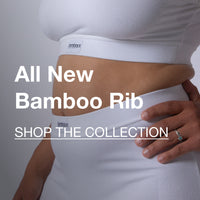What Is Jersey Fabric and What Makes It So Unique?

Jersey fabric is one of the most popular types of fabric in the United States. It’s one of the main materials that T-shirts are made from –– but its uses go far beyond just your everyday tee. Jersey is a type of knit that can be found in everything from beautiful couture gowns to the bedsheets you sleep on every night.
So what’s the big deal with jersey knit fabric, and why does it have such a hold on clothes and culture?
Today, we’re going to go a bit into the nitty-gritty of this popular medium-weight fabric, where it comes from, how it’s made, and its many uses in today’s society. Spoiler alert: it’s not just about sports jerseys.
Let’s get started!
What Is Jersey Fabric?
Contrary to popular belief, jersey fabric actually refers to a type of knit, not a fabric. It is used mainly in clothing; while jersey fabric used to be predominantly made of wool, it is commonly made of cotton as well as synthetic fibers nowadays.
Jersey knit fabric consists of interlocking loops. Standard jersey fabric consists of a single knit –– it is smooth on one side and piled on the other. A double-knit, or interlock, jersey fabric, on the other hand, is smooth on both sides. This type of knit results in a heavier, sturdier fabric that has a bit less stretch.
There are a few types of different variations of jersey: single jersey and double-knit jersey are the most common. You can also find interlock jersey, jacquard jersey, clocqué jersey, and stretch jersey. These jerseys do not have massive differences at first glance, but upon closer inspection, you can find varying degrees of stretch, draping, and strength.
What Are the Qualities of Jersey Fabric?
Stretchy and Soft
Because it is a knitted fabric, jersey tends to be pleasantly flexible. Like all cotton materials, jersey also feels luxuriously soft. Comfort is a huge plus for this type of fabric. That’s why stretch jersey knit material is often used for leggings, hoodies, and t-shirts.
When a high-stretch fabric is a must, jersey is sometimes mixed with other materials. This is where lycra Spandex jersey knit and rayon jersey knit fabrics come in handy.
Moisture-Wicking
This is one of the reasons that jersey is so popular in active wear. It has an absorbent, moisture-wicking quality. That makes it ideal for wear in sweaty or humid environments. Cotton jersey knit fabrics are more absorbent than many other cotton blends.
Breathable
Breathable without being overly thin or sheer, cotton jersey fabric makes for popular summer clothes. Because of its close-knit structure, it makes for opaque garments. Wonderful for both warm and cool days, jersey fabric allows for breeziness and breathability for the wearer.
Versatile
Jersey fabric is known for its versatility. Whether it’s for dresses, scarves, T-shirts, or even bedsheets, it has a variety of applications. Jersey fabric can create a lot of flattering fits due to its fine drape.
What Are the Origins of Jersey Fabric?
Jersey fabric is actually named after the island of Jersey in the English Channel islands.
The first production of jersey fabric was in the 15th century. It quickly became a staple amongst the island communities. The term “jersey” has worked its way into our clothing vocabulary because of the tunic-style pullovers and underwear that fishermen from this island used to wear.
The jersey fabric of the olden days was a lot heavier than what we know today. It continued to spread in popularity until the 19th century through Europe and the United States primarily in the form of athletic wear and uniforms.
In 1916, Coco Chanel discovered a new use for jersey fabric. During WWI, luxury fabrics were hard to find, especially for designers. Chanel decided to use jersey fabric she found in the store –– which was less expensive and quite comfortable –– to fashion dresses and suits with her sewing machine. Thus she achieved great success, and the jersey fabric we know and love was given new life in fashion.
The esteemed Madame Gres, a well-known titan in couture, used jersey to create gorgeous gowns from the 1930s to 1980s. The easily draped quality of jersey lent itself to creating beautiful ripples and folds in her dresses. Her use of cotton jersey fabric proves that it is as well suited for high-fashion as it is for everyday wear.
How Is Jersey Fabric Made?
Jersey fabric is commonly made from wool, organic cotton, synthetic fibers, or a mix of these. It is produced either by hand or via circular knitting machines that combine the necessary fabric fibers. The knitting machines get to work drawing each loop through the loop below it.
Standard jersey fabric is made with one set of needles, while double-knit jersey combines two pieces of single-knit jersey together. Vertical lines, or wales, of loops, make up the front of the fabric, while crosswise rows make up the back.
Jersey fabric can be dyed before or after a garment is knitted. Certain finishes may be added to give it extra durable qualities.
What Makes Jersey Fabric Different From Other Types of Fabric?
There are knit fabrics, and there are woven fabrics. Jersey is a knit fabric that has more stretch than woven fabrics. Because of this, it isn’t even necessary to add other stretch fibers like Spandex.
Apart from its natural stretch, jersey fabric is also notable for its breathability. There are lots of different types of breathable fabrics –– other cotton-based materials being among the most prominent –– but the great thing about jersey is that it is both breathable and opaque. That means you can enjoy a sheer vibe without feeling overly exposed.
Lastly, jersey fabric is unique for its many uses. Over history, it has proven its convenience in all walks of life: from athletics and underwear to T-shirts and runway glamor. You can’t help but love a versatile fabric.
What Is Jersey Fabric Used For?
High-quality jersey fabric is used for much more than the loose-fitting tops basketball players wear –– in fact, these kinds of “jerseys” are often not made of jersey knit fabric at all these days.
Here are some examples of where you may find jersey knit fabrics:
Sweatshirts and Sweatpants
Jersey fabric is a must-have lounge material. Smooth on the skin and ultra-flexible, it’s one of the most popular fabric types for a reason. The same qualities that make it popular for athleisure apply to its uses in regular sleep and loungewear, such as joggers, hoodies, and sweatshirts.
Bedsheets and Slipcovers
You may have cotton jersey bed sheets and not even know it! It’s true –– the softness and wrinkle-releasing elements of jersey fabric make it ideal for bed sheets and slipcovers.
It’s also a breathable fabric, so you won’t sweat so much during summer nights. Even heavyweight jersey sheets are breathable enough for summer nights.
Underwear and Hosiery
Back in Medieval times, jersey fabric was largely used to make underwear and hosiery. While today its uses have expanded, we still stick to some of the roots of this material. Because of its stretchiness and softness, jersey is excellently suited for undergarments.
Activewear
When you lead an active lifestyle, your clothes need to accommodate a lot of things: moving a lot, sweating a lot, and even the occasional abrasion.
Cotton jersey has been used in activewear for centuries now because of how well it accommodates these needs. This durable, breathable fabric has a bit of stretch even without added cotton Spandex blends; moisture-wicking capabilities also allow for it to be worn during heavy workouts and hot weather. Look for jersey activewear with four-way stretch flexibility.
Tees and Tanks
Cotton jersey fabric is a staple in the realm of T-shirts and tank tops. Because these items are mainly worn in the summertime, you can expect to go through some significant heat. That’s when the breathability of cotton jersey fabric really comes in handy. It’s also super soft, and we love putting comfort first when it comes to tees.
How Do You Take Care of Jersey Fabric?
With cotton jerseys, you want to be aware that shrinkage can occur. Try to avoid using excessive heat when washing or drying for this reason. Other than that, jersey knit fabrics are pretty easy to take care of. They also don’t wrinkle very easily, so you are unlikely to need an iron.
Final Thoughts: Jersey Fabric at TomboyX
At TomboyX, we take pride in our ultra-soft and comfortable clothes, from underwear to athleisure, everyday wear to lounge clothes and pajamas. We love using jersey knit fabrics to achieve the ultimate cozy and lightweight feel.
You can find tons of items in our French terry fabric, which is a very similar knit to a standard jersey. While some of our jersey knit fabrics are in cotton, you can also find jersey knits made from TENCEL™ Modal, a material sustainably sourced from renewable beechwood trees.
If you’re a fan of stretchy, breathable material with a luxurious feel, you can’t go wrong with some jersey knit tops and bottoms!
Sources:
sweater | clothing | Britannica
What is Modal fiber? | Modal fiber properties | TENCEL™ Modal fibers
How Coco Chanel changed the course of women's fashion | CNN Style





